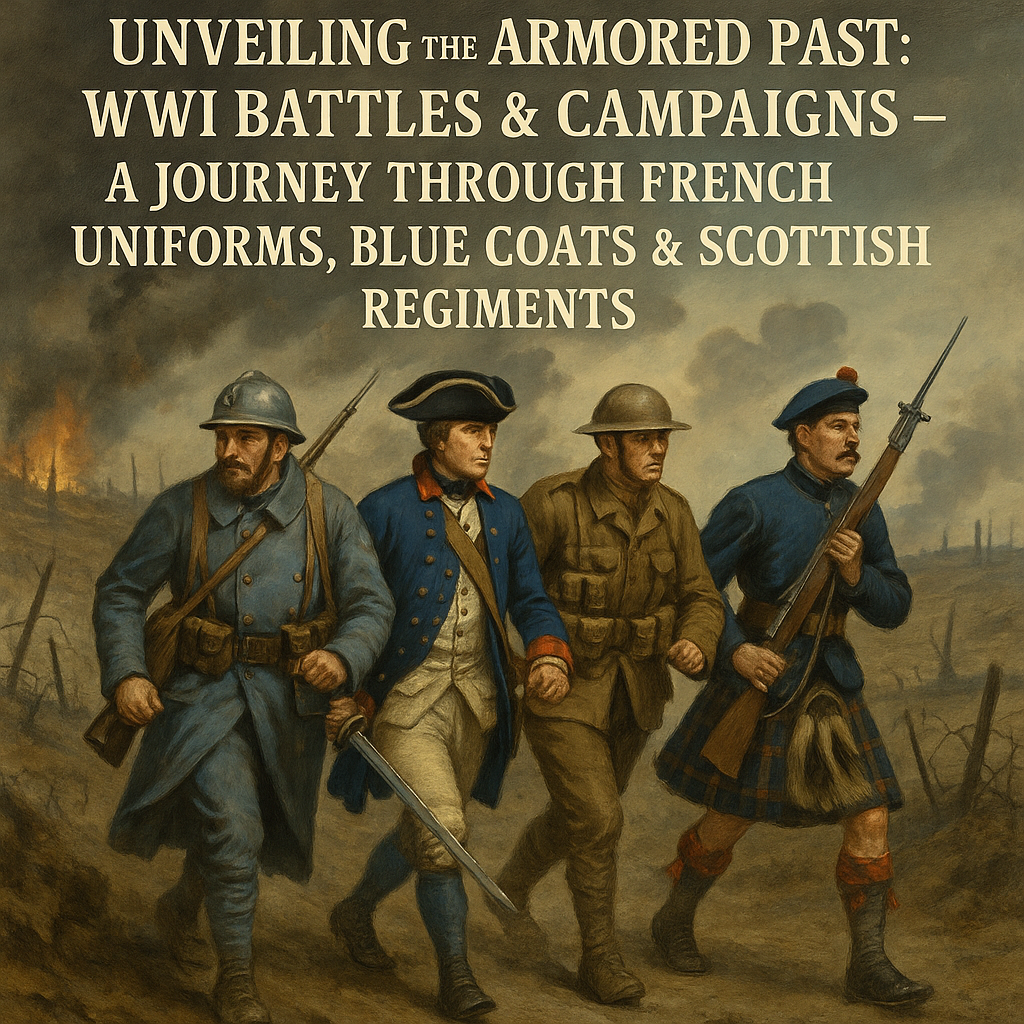
Unveiling the Armored Past: WWI Battles & Campaigns – A Journey Through French Uniforms, Blue Coats & Scottish Regiments”
Published on Jun 22, 2025
Introduction: Why WWI Battles and Uniforms Matter
World War I wasn’t just a clash of nations—it was a turning point that redefined warfare, national identities, and military attire. For collectors and reenactors browsing paddelaters.com, each uniform—from the French horizon-blue tunic to the tartan kilts of Highland Scots—carries layers of symbolism and battlefield legacy. Let’s march through the key theaters of WWI, understand pivotal campaigns, and connect the dots to closely related eras, including the American Revolution’s blue coats and Scotland’s distinctive uniforms.
1. ⚔ Major WWI Battles & Campaigns
1.1 The First Battle of the Marne (September 1914)
A defining moment that halted Germany’s sweep toward Paris, the First Battle of the Marne set the tone for trench warfare. French and British troops, wearing iconic horizon-blue coats (shown in our French WWI uniform collection), clashed with German forces in a muddy stalemate.
Uniform Spotlight:
- French horizon blue tunic
- Adrian steel helmet (introduced mid-war)
- Puttees and breeches—highlighted in our French WWI uniforms pillar
1.2 Battle of Verdun (February–December 1916)
The longest battle of WWI became a symbol of French resolve. Verdun’s trenches and shell-blasted terrain tested the durability of French uniforms. Heavy mud and artillery rain demanded reinforced boots, durable fabrics, and gear carcasses—key elements emphasized in collector-grade reproductions.
1.3 Battle of the Somme (July–November 1916)
This joint French-British offensive introduced the world to creeping artillery barrages, tanks, and mass infantry waves. Close-quarters combat led to quick wear and tear, necessitating durable tunics, leggings, and steel helmets—again featured in our French WWI uniform line.
1.4 Italian Front & Eastern Theaters
While less iconic, these fronts paid heavy tolls and saw uniform variations adapted to alpine warfare and cold conditions. Trench coats, heavier fabrics, and boots were common—items that resonate with reenactors seeking accuracy.
2. 🇫🇷 Focus on French Uniforms in WWI & WWII
2.1 French WWI Uniform
The “horizon blue” tunic replaced the traditional red trousers and dark bluecoat, offering camouflage and morale. The iconic Adrian helmet, introduced in 1915, provided vital protection.
Our Collection Highlights:
- Replica horizon-blue tunics (early vs. late-war cuts)
- Adrian helmets (steel-liner combos)
- Matching breeches, puttees, leather gaiters
2.2 French WWII Uniform (Pillar Page)
WWII brought the transition from Adrian to the German-esque MS 1931 cap and updated combat jackets. While beyond our WWI focus, it’s essential for collectors transitioning through eras.
3. 🧭 Linking to the “Blue Coats American Revolution” Page
Before the khaki and gray of modern warfare, the blue-coated Continental Army marched into history. Though separated by a century, early American uniforms inspire authenticity in reenactments and collections today.
- Blue Coat Highlights:
- Coal-black lapels and brass buttons
- Wool breeches and buff waistcoats
- Tri‑corner hats or cocked caps
These pieces appeal to collectors exploring the evolution of military uniform design—from clean-cut 18th-century coats to scuffed, mud‑stained khaki of WWI.
4. 🥋 The Charm of Scottish Uniforms
Scottish regiments, from kilts to bonnets to large sporrans, exhibit one of the most charismatic military identities in history. Though not dominant on Western Front battlefields, Highland units served valiantly—with distinctive dress variations during and after WWI.
Scottish Uniform Collection Features:
- Kilts with regimental tartans
- Woolen hose, flashes, and ghillie brogues
- Plaids and tam o’ shanters as everyday wear
5. 📝 Tips for Collectors & Reenactors
- Know Your Era: WWI horizon blue differs drastically from WWII fatigue gray or Tan khaki of American Revolution reenactments.
- Focus on Fabric & Cut: Choose wool blends and proper tailoring for authenticity.
- Pay Attention to Details: Brass buttons, correct helmet liner date stamps (e.g., “A” series), and regimental insignia enhance accuracy.
- Proper Care: WWI uniforms need gentle cleaning and mending—replace where appropriate, not always restore.
- Mix & Match: Reproductions from our French uniform pillar pair well with authentic accessories like Julian leather belts or reproduction webbing.
6. 🤝 Bridging the Pillar Pages
- French WWII Uniform: Fans of WWI pieces often collect adjacent WWII gear. We provide WWII jackets, trousers, insignes, and gaiters to complete any interwar collection.
- Blue Coats (American Revolution): Expand the collection backward to explore uniform evolution over 150 years.
- Scottish Uniforms: Add kilts and regalia to bring variety and dignity to any military display.
7. 🚀 SEO Benefits: Keywords & Structure
- Consistent use of blue coats American Revolution and Scottish uniforms ensures visibility for related searches.
- Coverage of WWI campaign names (Marne, Verdun, Somme) targets history buffs and reenactors alike.
- Pillar pages interlink strategically—boosting internal SEO and building relevance signals for Google.
- Meta tags and headings align with long-tail and targeted searches.
8. 🧩 Bringing It All Together: Suggested Article Structure
- Intro: WWI context + uniform importance
- Key Battles: Marne, Verdun, Somme, Other fronts
- Uniform Deep Dive: French flyers, helmet styles, trench gear
- Historic Connections: Blue coats, Scottish regiments
- Collector’s Guidance: Care, sourcing, authenticity
- Call to Action: Visit pillar pages for gear, accessories, or reenactment support
9. ✅ Conclusion
By weaving together WWI campaigns and uniform evolution—from French green‑blue tunics to American blue coats and Scottish kilts—you create a compelling, SEO-optimized article that appeals to historians, collectors, and hobbyists. With internal links to pillar pages, keyword relevance, and easy‑to‑understand language, this piece is built to drive traffic and conversions for your niche war-related uniform site.
